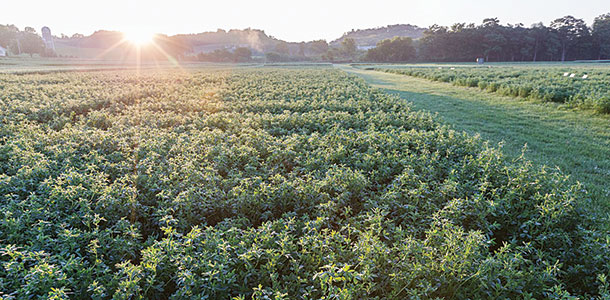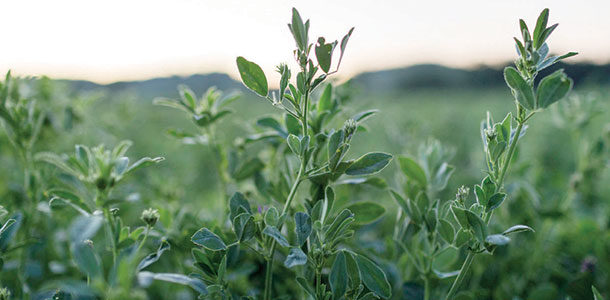This could be good news for forages, an industry that does not encounter planted acre fluctuations as pronounced as those of corn, soybeans or wheat. Yet, 2015 might prove to be an unpredictable year for alfalfa.
The U.S. experienced a decrease in alfalfa acres for decades until 2012, when the number of acres started gradually increasing by a few percentage points. I wouldn’t be surprised to see this happen again in 2015.
Reasons could include lower commodity prices on corn and other competing crops, above-average hay price and demand, and an increase in available water – whether in the form of rain or snow – primarily in the Southern Plains and Southwest.
While these three factors could help spur an increase in alfalfa acres, here is an overall look at areas I believe will have a particular influence on the alfalfa market this year.
Slumping milk prices
All things considered, Class III milk prices will most likely have the greatest bearing on alfalfa acres in 2015. Of all fundamentals in the market tied to alfalfa acres, milk prices are usually most closely correlated. Milk prices are dropping, and forecasts say they will continue to do so, at least in the short term.
Alfalfa hay is relatively expensive currently compared to other feedstuffs, causing many dairy producers to wonder if they can obtain the production they need and keep costs under control if they feed less alfalfa.
If hay prices happen to go up and milk prices fall more than forecasted, alfalfa acres could decrease.
Though I don’t foresee a dramatic increase or decrease in alfalfa acres this year, I would say that alfalfa acres seem poised to increase slightly again nationally in 2015.
Water issues
Alfalfa is obviously a drought-tolerant crop, but it needs adequate water for high yields. Last year in the Southern Plains, we saw how the lack of available water greatly influenced alfalfa acres. It was a similar story in California’s Central Valley and southern area.
California has about 900,000 available acres, and that number won’t go up unless available water increases in 2015.
 California is in a 100-year drought. Even though the state has experienced weather patterns that have brought some moisture into the Central Valley and the Sierra Nevada mountains, it’s not enough to alleviate the drought any time soon.
California is in a 100-year drought. Even though the state has experienced weather patterns that have brought some moisture into the Central Valley and the Sierra Nevada mountains, it’s not enough to alleviate the drought any time soon.
The California alfalfa market may turn around, but it’s going to take additional water to make that happen. If California farmers don’t have a good market for alfalfa hay into dairies or export because of continued lack of rainfall, we’ll see continued competition from permanent and other competing crops.
Expanding into beef markets
With beef prices at or close to all-time-high feeder and live cattle prices, many beef producers who had previously relied on cheaper feedstuffs are looking for higher-quality forage, such as alfalfa hay.
This rise in alfalfa demand from beef producers should continue to provide additional markets for beef producers and cash hay growers.
However, beef cattle don’t demand as high-quality alfalfa as, for example, an early lactation, high-producing dairy cow. Alfalfa is still predominantly raised for dairy use and export, with beef usage further down the line. But producers in some areas who raise beef cattle are taking a closer look at growing alfalfa.
This is usually because of quality benefits, i.e., a cheaper protein source or additional yield compared to other forage hay crops.
For example, if growers raise 6-ton alfalfa hay versus 3-ton grass hay, not only do they need half the acres to meet hay needs, they’ll usually have a higher-quality feedstuff. So it is not only a tonnage decision but also a time and investment decision.
Yield versus quality decisions
Alfalfa growers continually face the yield versus quality trade-off. Though alfalfa yield and quality goals differ depending on the grower or producer, looking more long term at alfalfa acres over the next several years, a new technology will help to ease the yield or quality trade-off.
Low-lignin alfalfa was recently deregulated by the USDA. The trait should help ease the yield versus quality trade-off by sustaining forage quality over a longer period, providing greater flexibility and a wider cutting window to maximize yield potential.
A limited commercial introduction of lower-lignin alfalfa will allow growers to start realizing the value and benefits of this technology. FG
PHOTOS
Hayward notes that several factors will have an influence on the alfalfa market this year, including slumping milk prices and water issues. Photos courtesy of Jeremy Hayward.

- Jeremy Hayward
- Brand Manager
- W-L Research











